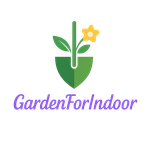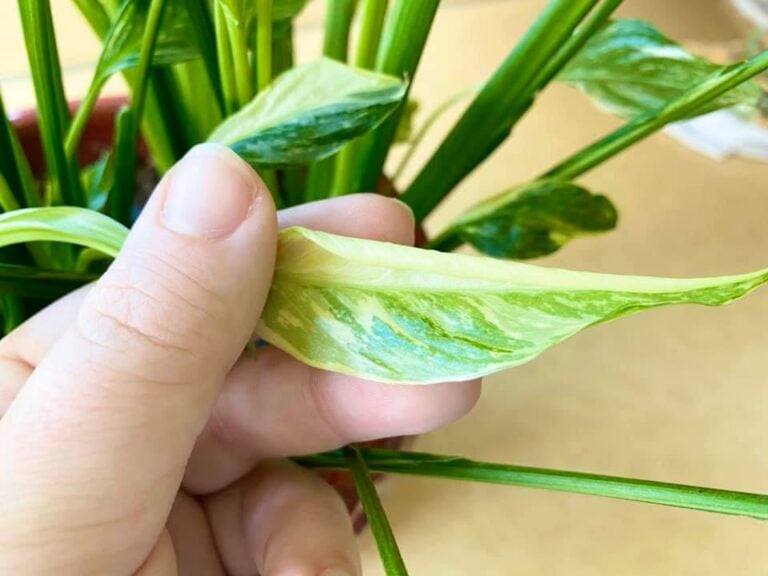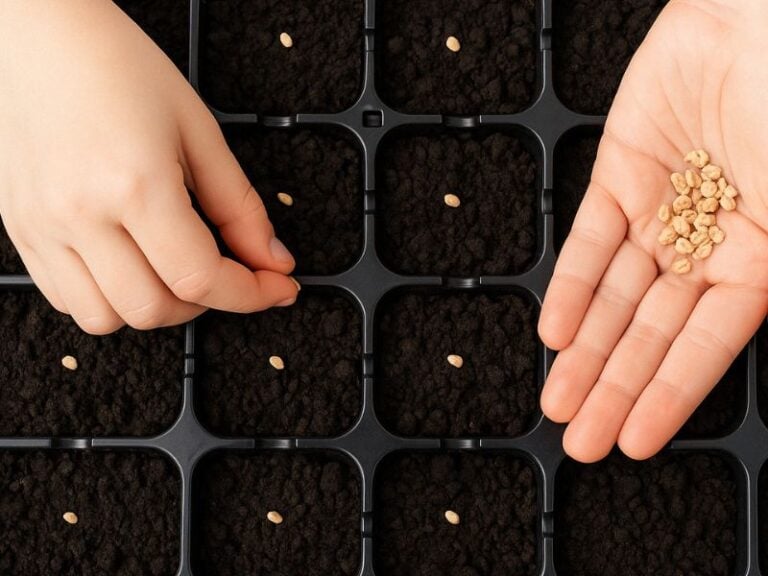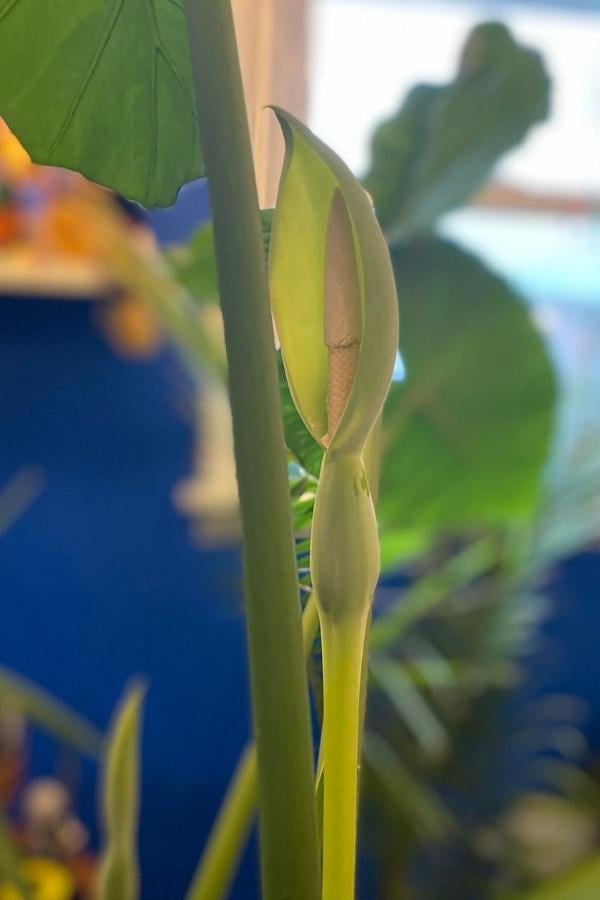In nature, peace lilies grow outdoors in tropical climates. Yet, most of us who don’t live in tropical regions know them as potted plants. I will share how to create the best possible soil for these lovely plants, so you can give them the life they deserve.
Soil with excellent drainage and aeration is best for indoor peace lilies. Besides proper drainage, the soil needs to retain enough moisture for the root system to function properly. Also, the soil should be capable of meeting the plant’s nutrient requirements.

Contents
Peace Lily Soil Requirements
To select the proper soil for your peace lily, it’s important to know how it grows in nature. Peace lily comes from humid tropical regions, often found along riverbanks, near bodies of water, and in marshy areas. The soil in these places is rich in fallen, decayed leaves and branches, as well as peat.
Such soil is usually light, airy, and moist. This means a similar type of soil should work well for your indoor peace lily.
The soil also needs to be breathable and have a neutral or slightly acidic pH (around 5.5). To increase soil aeration, gardeners often add coarse sand and ensure good drainage with materials like expanded clay pellets, small pebbles, or crushed brick.
Also, the ingredients below can help you avoid compaction:
| Ingredient | Description |
|---|---|
| Vermiculite | A mineral ideal for peace lilies, as they need frequent watering. It helps with soil aeration and also holds and releases minerals when needed. Because of the extra nutrients it provides, I prefer to use this for my peace lilies. |
| Perlite | Another great ingredient that improves aeration. It’s a rock-based material that offers excellent drainage. Its purpose isn’t to provide nutrients, but to help with drainage and aeration. |
| Sand | Coarse sand is one of the cheapest ingredients you can add to improve drainage. It’s lightweight, doesn’t compact, and breaks up soil clumps. |
To reduce acidity, you can add slaked lime, dolomitic lime, or wood ash. Conversely, if the soil is too alkaline, you can raise acidity with peat, leaf mold, or fertilizers containing ammonia.
So, if you love your peace lily and want it to bloom actively, choose a light, loose, humus-rich soil that stays moist, and make sure the pot has good drainage.
Ready-made Soil Mix
These days, many garden centers and stores sell ready-made potting mixes for various plants. Some are even specifically labeled for peace lilies. If you can’t find one made just for peace lilies, look for those formulated for aroids or for flowering tropical houseplants.
As a last resort, buy a universal potting mix and adjust it slightly. Universal mixes often have higher acidity and can be heavier than ideal for aroids, so be sure to add sand, ash, perlite, shredded coconut fiber, or finely chopped bark. You don’t have to add all of these—just a few in different combinations, and no more than about 10% total.
When purchasing any soil, always pay attention to its composition, pH value, and for which plants it’s intended. Reputable manufacturers list all this information on the packaging.
For example, you might find:
- A special potting mix for aroid-family plants that contains coarse-porous aerators, high-quality peat, expanded clay, river sand, calcium, and other carefully selected minerals. Its pH might range around 5–6.
- A balanced mix labeled for aroids that includes about 45% potting soil, 25% moss, 25% sand, and 5% charcoal.
- A nutrient-rich “aroid” substrate that might contain sand, sphagnum moss, perlite, charcoal, peat, vermicompost, and turf soil. In some products, these components are layered so you can mix them as you prefer.
Unfortunately, even store-bought mixes don’t guarantee 100% quality. After planting your peace lily, observe it for a while to see how it’s doing. In the worst case, you may have to replace the soil and repot the plant.
Succulent & Cactus Soil Mix: this is the one I use the most and highly recommend to everyone who is trying to find a good mix.
How to Prepare Soil Yourself (DIY)
If you’re new to growing houseplants, it’s better to start with a ready-made potting mix. At home, you can also use a universal potting mix and add sand if possible. Just remember to rinse or heat the sand before use to disinfect it.
More experienced gardeners often prefer to make their own soil, especially if they have a country home with space to prepare various components.
Key ingredients might include garden or turf soil, compost, well-rotted manure, coarse sand, finely chopped bark, decomposed leaves or pine needles, peat (preferably from higher peat bogs, as low-lying peat is more acidic), charcoal, and ash.
If you use soil as a base, add other components in roughly a 1-to-10 ratio (except sand, which can be added a bit more generously).
Always use only well-decomposed plant material, and sterilize your potting mix with a strong potassium permanganate solution.
Nowadays, components like perlite, vermiculite, coconut fiber, and sphagnum moss are also available. Sphagnum and charcoal have bactericidal properties.
Perlite, made of tiny porous granules of volcanic rock, adds fluffiness and airiness to the soil. Vermiculite, a mineral from the mica family, has a complex chemical makeup that enriches the soil with microelements.
When preparing a substrate for peace lilies, don’t forget about fertilizers. The easiest approach is to use a balanced fertilizer containing nitrogen, potassium, and phosphorus. There are many such fertilizers from various manufacturers.
Consequences of Choosing the Wrong Soil
If you pot your peace lily correctly, following all soil requirements, it won’t be prone to diseases or drying out, and it will delight you with lush blooms year-round since it hardly has any dormant period. Otherwise, you might face some unpleasant surprises.
Even with proper, timely watering, heavy, dense soil can trap moisture and block airflow, causing roots to rot. As a result, the plant may stop growing and blooming, and it can even die.
Generally, for flowering houseplants to thrive, they need to be slightly root-bound in smaller pots. If your peace lily refuses to bloom despite everything, the soil mix might be at fault. In that case, consider changing it or adding some loosening components. As an option, try adding potassium-based fertilizers.
Insufficient soil moisture or incorrect acidity can cause spots on leaves and weaken the plant overall. A weakened plant is more susceptible to diseases and pests.
Also, remember that poor-quality soil can contain insect larvae from the start. The most common pests include scale insects, root aphids, and spider mites.
If you notice white bugs on the stems and leaves, this might be mealybugs. Naturally, you should immediately take steps to eliminate them—treat the soil or repot the plant into fresh soil.
If the soil isn’t treated thoroughly before planting, it could contain spores of fungal diseases (like root rot or phytophthora). Heavy, compacted soil that causes waterlogging, or a cold windowsill where the peace lily stands, will almost certainly lead to the plant’s demise.
In conclusion, the peace lily is quite an undemanding plant. By knowing a few simple rules and growth conditions, along with providing minimal ongoing care, your peace lily can bloom and remain vibrant all year, offering you a sense of comfort and satisfaction day after day.






